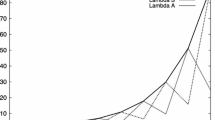Abstract
This paper is devoted to a family of interpolation type problems for positive trigonometric polynomials of a given ordern. Via the Riesz-Fejér factorization theorem, they can be viewed as natural generalizations of the partial autocorrelation problem for discrete time signals of lengthn+1. The relevant variables for a specific problem are well-defined linear combinations of the coefficients of the underlying trigonometric polynomial. An efficient method is obtained to characterize the feasibility region of the problem, defined as the set of points having these variables as coordinates. It allows us to determine the boundary of that region by computing the extreme eigen values and the corresponding eigenvectors of certain well-defined Hermitian Toeplitz matrices of ordern+1. The method is an extension of one proposed by Steinhardt to solve the coefficient problem for positive cosine polynomials (which belongs to the family). Other interesting applications are the Nevanlinna-Pick interpolation problem for polynomial functions, and the simple interpolation problem for positive trigonometric polynomials. The close connection between the generalized Steinhardt method and classical techniques based on the polarity theorem for convex cones and on the Hahn-Banach extension theorem are established.
Similar content being viewed by others
References
[A] N. I. Akhiezer,The Classical Moment Problem, Oliver and Boyd, London, 1965.
[BH] J. A. Ball and J. W. Helton, Interpolation problems of Pick-Nevanlinna and Loewner types for meromorphic matrix functions: parametrization of the set of all solutions,Integral Equations Operator Theory,9 (1986), 155–203.
[B] J. P. Burg, Maximum Entropy Spectral Analysis, Ph. D. dissertation, Stanford University, Stanford, CA, 1975.
[C] G. Cybenko, Moment problems and low rank Toeplitz approximations,Circuits Systems Signal Process.,1 (1982), 345–366.
[D1] J. D. Davis,Circulant Matrices, Wiley, New York, 1979.
[DG] P. Delsarte and Y. Genin, Spectral properties of finite Toeplitz matrices, inMathematical Theory of Networks and Systems (P. A. Fuhrmann, ed.), pp. 194–213, Lecture Notes in Control and Information Sciences, Springer-Verlag, Berlin, 1984.
[DGK1] P. Dolsarte, Y. Genin, and Y. Kamp, On the role of the Nevanlinna-Pick problem in circuit and system theory,Circuit Theory Appl.,9 (1981), 177–187.
[DGK2] P. Delsarte, Y. Genin, and Y. Kamp, Parametric Toeplitz systems,Circuits Systems Signal Process.,3 (1984), 207–223.
[DGK3] P. Delsarte, Y. Genin, and Y. Kamp, Zero location of lacunary prediction polynomials,IEEE Trans. Acoust. Speech Signal Process.,35 (1987), 1346–1347.
[DGKD] P. Delsarte, Y. Genin, Y. Kamp, and P. Van Dooren, Speech modelling and the trigonometric moment problem,Philips J. Res.,37 (1982), 277–292.
[D2] B. W. Dickinson, Two-dimensional Markov spectrum estimates need not exist,IEEE Trans. Inform. Theory,26 (1980), 120–121.
[F1] L. Fejér, Über trigonometrische Polynome,J. Reine Angew. Math.,146 (1915), 53–82.
[F2] L. Fejér, Über eine Aufgabe der Harnackschen Potentialtheorie,Nachr. Ges. Wiss. Göttingen (1928), 109–117.
[FL] S. Friedland and R. Loewy, Subspaces of symmetric matrices with a multiple first eigenvalue,Pacific J. Math.,62 (1976), 389–399.
[G] T. T. Georgiou, Realization of power spectra from partial covariance sequences,IEEE Trans. Acoust. Speech Signal Process.,35 (1987), 438–449.
[GG] R. K. Goodrich and K. E. Gustalson, Spectral approximation,J. Approx. Theory,48 (1986), 272–293.
[GS] U. Grenander and G. Szegö,Toeplitz Forms and Their Applications, University of California Press, Berkeley, CA, 1958.
[J] C. R. Johnson, Numerical determination of the field of values of a general complex matrix,SIAM J. Numer. Anal.,15 (1978), 595–602.
[KMS] M. Kac, W. L. Murdock, and G. Szegö, On the eigen-values of certain Hermitian forms,J. Rational Mech. Anal.,2 (1953), 767–800.
[K] G. Köthe,Topological Vector Spaces 1, Springer-Verlag, Berlin, 1969.
[LM] S. W. Lang and J. H. McClellan, Spectral estimation for sensor arrays,IEEE Trans. Acoust. Speech Signal Process.,31 (1983), 349–358.
[M] K. N. Majindar, Linear combinations of Hermitian and real symmetric matrices,Linear Algebra Appl.,25 (1979), 95–105.
[R1] W. Rudin, The extension problem for positive-definite functions,Illinois J. Math.,7 (1963), 532–539.
[R2] S. Ruscheweyh, Non-negative trigonometric polynomials with constraints,Z. Anal. Anwendungen,5 (1986), 169–177.
[S1] S. Sarason, Generalized interpolation inH ∞,Trans. Amer. Math. Soc.,127 (1967), 179–203.
[S2] A. O. Steinhardt, Correlation matching by finite length sequences,IEEE Trans. Acoust. Speech Signal Process.,36 (1988), 545–559.
A. O. Steinhardt, The partial realization problem for moving average models,Proceedings of the IEEE International Conference on Acoustics, Speech and Signal Processing, New York, 1988, pp. 2360–2363.
[SM] A. O. Steinhardt and J. Makhoul, On the autocorrelation of finite length sequences,IEEE Trans. Acoust. Speech Signal Process.,33 (1985), 1516–1520.
[SW] J. Stoer and C. Witzgall,Convexity and Optimization in Finite Dimensions I, Springer-Verlag, Berlin, 1970.
[S4] O. Szàsz, Über harmonische Funktionen undL-Formen,Math. Z.,1 (1918), 149–162.
[S5] G. Szegö, Koeffizientenabschätzungen bei ebenen und räumlichen harmonischen Entwicklungen,Math. Ann.,96 (1927), 601–632.
[T1] O. Taussky, Positive-definite matrices, inInequalities (O. Shisha, ed.), pp. 309–319, Academic Press, New York, 1967.
[T2] A. E. Taylor,Introduction to Functional Analysis, Wiley, New York, 1964.
[U1] F. Uhlig, A recurring theorem about pairs of quadratic forms and extensions: a survey,Linear Algebra Appl.,25 (1979), 219–237.
[U2] F. Uhlig, The field of values of a complex matrix, an explicit description in the 2 × 2 case,SIAM J. Algebraic Discrete Methods,6 (1985), 541–545.
Author information
Authors and Affiliations
Rights and permissions
About this article
Cite this article
Delsarte, P., Genin, Y. & Kamp, Y. Interpolation type problems in the class of positive trigonometric polynomials of fixed order. Math. Control Signal Systems 2, 171–185 (1989). https://doi.org/10.1007/BF02551820
Received:
Revised:
Issue Date:
DOI: https://doi.org/10.1007/BF02551820



